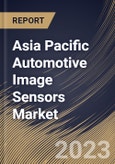Image sensors are continuously evolving to offer higher resolution, enabling sharper and more detailed image capture. This is particularly crucial for applications like autonomous driving and advanced safety systems, where fine details can make a significant difference. Automotive image sensors are increasingly integrated with artificial intelligence (AI) and machine learning algorithms. This allows for more sophisticated object recognition, improved object tracking, and enhanced decision-making capabilities in real-time. Integrating various sensor technologies, such as radar, lidar, and image sensors, is becoming common. Combining these sensors provides a more comprehensive and redundant approach to perception systems, enhancing safety and reliability.
In addition, image sensors are becoming smaller and more discreet, enabling their integration into various interior and exterior vehicle features. In-cabin monitoring for driver alertness and passenger well-being is a growing trend, with applications expanding beyond safety to personalization and comfort. The fusion of image and LiDAR (Light Detection and Ranging) sensors is emerging as a powerful trend in autonomous vehicles. This combination provides a rich dataset for autonomous navigation and object recognition.
Furthermore, in accordance with the data from the National Investment Promotion and Facilitation Agency of India, between April 2021 and March 2022, the automotive sector produced a total of 22.93 Mn vehicles, including passenger cars, trucks, three-wheelers, two-wheelers, and quadricycles. India’s automotive industry is worth more than $222 Bn and contributes 35% to Manufacturing GDP. The automobile sector is the 5th highest FDI inflow-receiving sector as of June 2023. Owing to the rise in automotive sector in Asia Pacific will boost the demand for automotive image sensors in the region.
The China market dominated the Asia Pacific Automotive Image Sensors Market, By Country in 2022, and would continue to be a dominant market till 2030; thereby, achieving a market value of $805.5 million by 2030. The Japan market is registering a CAGR of 10.6% during (2023 - 2030). Additionally, The India market would showcase a CAGR of 12.1% during (2023 - 2030).
Based on Technology, the market is segmented into CMOS, and CCD. Based on Vehicle Type, the market is segmented into Passenger Vehicles, and Commercial Vehicles. Based on countries, the market is segmented into China, Japan, India, South Korea, Singapore, Malaysia, and Rest of Asia Pacific.
The market research report covers the analysis of key stake holders of the market. Key companies profiled in the report include Samsung Electronics Co., Ltd. (Samsung Group), Continental AG, Infineon Technologies AG, Denso Corporation, OmniVision Technologies, Inc., Sharp Corporation (Hon Hai Precision Industry Co., Ltd), NXP Semiconductors N.V., Gentex Corporation, Canon, Inc., and Teledyne Technologies, Inc.
Scope of the Study
Market Segments Covered in the Report:
By Technology (Volume, Thousand Units, USD Million, 2019-2030)- CMOS
- CCD
- Passenger Vehicles
- Commercial Vehicles
- China
- Japan
- India
- South Korea
- Singapore
- Malaysia
- Rest of Asia Pacific
Key Market Players
List of Companies Profiled in the Report:
- Samsung Electronics Co., Ltd. (Samsung Group)
- Continental AG
- Infineon Technologies AG
- Denso Corporation
- OmniVision Technologies, Inc.
- Sharp Corporation (Hon Hai Precision Industry Co., Ltd)
- NXP Semiconductors N.V.
- Gentex Corporation
- Canon, Inc.
- Teledyne Technologies, Inc.
Unique Offerings
- Exhaustive coverage
- The highest number of Market tables and figures
- Subscription-based model available
- Guaranteed best price
- Assured post sales research support with 10% customization free
Table of Contents
Companies Mentioned
- Samsung Electronics Co., Ltd. (Samsung Group)
- Continental AG
- Infineon Technologies AG
- Denso Corporation
- OmniVision Technologies, Inc.
- Sharp Corporation (Hon Hai Precision Industry Co., Ltd)
- NXP Semiconductors N.V.
- Gentex Corporation
- Canon, Inc.
- Teledyne Technologies, Inc.
Methodology

LOADING...








